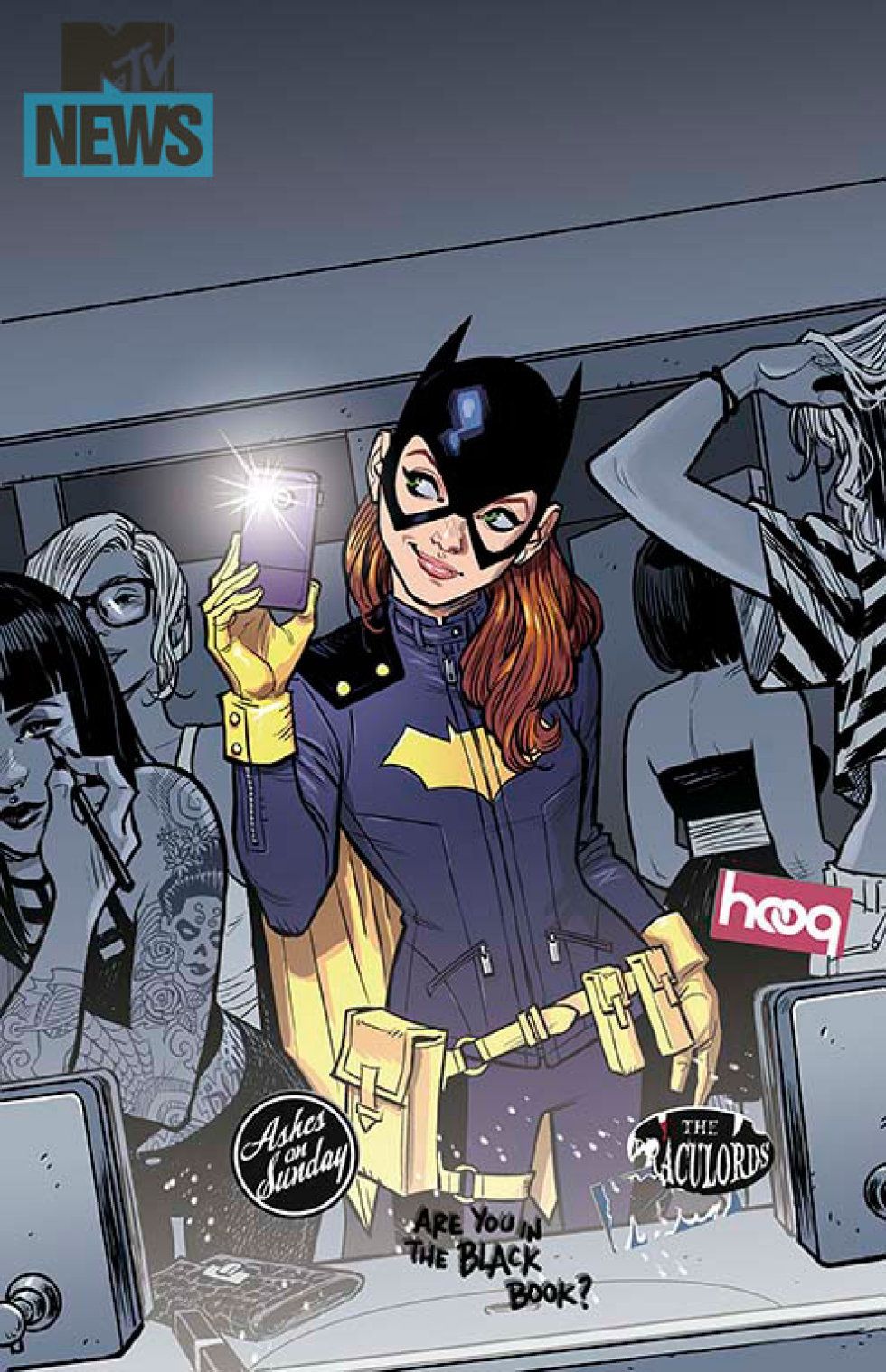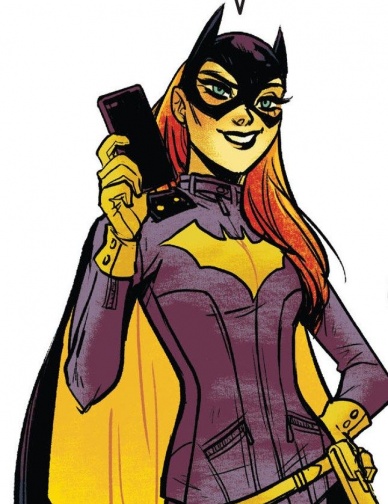
After undergoing a reboot with a new creative team, “Batgirl” has been through some major changes. In order to process what this new direction means for Barbara Gordon, I contacted my favorite person to talk about Batgirl with, Dr. Will Brooker. Will and I had an in-depth conversation about what Stewart, Fletcher and Tarr bring to the title and to the character.
Join us as we explore this new incarnation of Babs in the first installment of the monthly column, The Burnside HOOQ-Up.
Sam LeBas: What were your first reactions to this new rendition of Barbara Gordon?
Will Brooker: My first reaction was that seeing Babs half-dressed on page 2 bothered me when I saw it in the preview. I’m much more comfortable with it in the context of the story as a whole, but I still think it’s worth asking questions about why a female protagonist is depicted that way at the very start of her reboot, and what it means more broadly. I don’t think we can see it entirely in isolation from the very long and undistinguished tradition and context of showing women half-dressed in superhero comics: my article Batgirl’s Last Dance online lists some recent examples. On the other hand, I feel the writing and the artwork come across in a distinct way here, which separates it from those more stereotypical depictions.
I mean she is pretty hungover, she isn’t really depicted in a way you’d consider sexual (though the fact that she covers up as soon as she sees a guy draws attention to her state of undress). This depends on my own very subjective sense of Barbara’s character, but the ‘Barbara I know’ would not walk around in underwear in front of people she doesn’t know well. I see her as very cagey and private.
SL: Are you sure she doesn’t know Frankie well?
WB: Apparently she met Frankie three years ago, but we never heard about Frankie before, so a leap of faith is involved here from the reader. Babs had this pal for three years and we never heard about her? Frankie has never met Alysia, so… it’s hard for us to know. The small type on page 2 announces ‘A NEW ERA OF BATGIRL’ and I think we have to take that into account and give this team a chance to start afresh, introducing their own elements and secondary characters.
So, we don’t know how well Babs knows Frankie and Liz. It’s her first day in the new house. She’s hungover. I cannot say, from all those factors, whether Babs would walk around in little panties or not. My initial feeling from the preview was that this puts Babs into that long-established tradition of half-dressed superheroines in comics. That was my first reaction, and on reflection I think we can see it differently, but it’s worth considering.
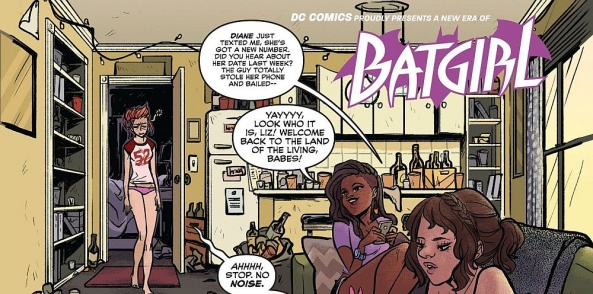
SL: She rolls out of bed that way.
WB: Yeah, but people might throw something on.
SL: She’s wearing the shirt from the night before.
WB: I know it is possible to explain it. The way it’s drawn and the way it happens in the story is very different from Vicki Vale posing in her fancy lingerie while she dictates her diary in All-Star Batman. Surely, though, we should also consider a long established context of the way women are represented in comics, and popular culture more broadly.
SL: It doesn’t seem forced.
WB: I’m not condemning it at all. But I think it is worth looking at and asking, is this different? If so, how is it different from all the other images in comics of women in underwear, from Starfire to Catwoman to Wonder Woman to Oracle to Harley, to Ivy?
I think it is worth looking at and asking the question. Would we see Bruce like this on page 2 of a reboot, in skimpy briefs?
SL: We wouldn’t see Bruce palling around with a bunch of guys after a house party, either. But he’s shirtless a lot.
WB: We would see Bruce getting out of bed, and true, we see him shirtless quite a lot in Snyder and Capullo because Capullo loves drawing muscles.
Continued belowI’m simply saying it is worth asking. It’s worth saying of any depiction, is this different, does this work, can it be plausible and reasonable to show women in underwear in comics as part of a story? If so, how does this team successfully do it? At best, we could say here’s an example for other creators. This could serve as an example of how to do it legitimately, and not gratuitously.
SL: I am just saying I don’t think you can draw a parallel between Bruce and Barbara in that way.
WB: No, but it’s an interesting route in. Would a male character be drawn like this? It’s not the final answer by any means, but it’s a way of approaching it. That’s what the Hawkeye Initiative was all about. Would we draw men in this outfit, with this pose?
If you prefer, would we see Dick like this? Would we see Dick in underwear? Put it that way.
Would we look at a page, and there is Dick, coming out of underwear? Ask yourself?
I mean, coming out in his underwear.
SL: She does not look very dignified.
WB: But I think that’s part of what makes it work. She is not being presented as something to be looked at. She’s not there for the heterosexual male reader, not obviously anyway.
SL: She’s just hungover, she has to exit her bedroom to even get to the bathroom. I buy it.
WB: Of course she has to exit her bedroom, Samantha, but don’t you think Barbara owns sweatpants if she wanted to pull them on? What does she wear for yoga?
I think by making it clearly plausible as part of the story, as you point out – she wore that shirt last night – and by presenting her as grumpy, dozy and hungover, the scene works, but don’t you agree it’s worth looking at why this works and how it’s different from other depictions of half-dressed women in superhero comics?
SL: Really, I can imagine someone like Fraction’s Hawkeye being shown in a similar way.
WB: Ok, but bear in mind I am not criticising. I am saying this was my initial response. We can consider this as maybe a good example of how to do something, which others should follow and learn from, or at least think about.
SL: I think there is an interesting comment to be made about what the presence of a man in the room does to her self-perception.
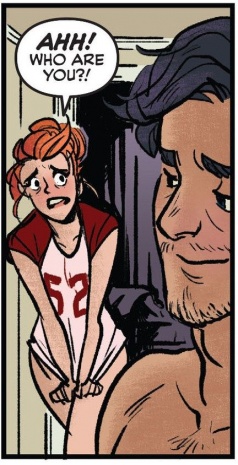
WB: I agree, and, yes it is interesting the way a male ‘viewer’/reader changes the dynamic.
SL: The moment it becomes sexualized is the moment she becomes uncomfortable.
WB: I agree. Which kind of establishes the sense of Babs being quite a private person, except when she’s drunk. Also, it gives us this sense that she’s comfortable around women, which is very plausible after three years sharing an apartment with Alysia. She’s spent so much of her life, I imagine, in sports, yoga, martial arts, physio, that she sees nothing in getting changed or being half-dressed in front of women. Which is convincing in character terms.
SL: Or maybe she and Frankie and Liz have been hanging out in their underwear for three years, who knows?
WB: Yeah who knows except that we saw Babs for the last three years and never heard about this area, these women, this house and so on. We know because we saw what Babs was doing, and she was marrying Joker, killing her brother and whatever else.
Be real. My fan explanation was fine. Babs is very used to being half-dressed in female spaces and comfortable with her body.
SL: I don’t think there is anything damaging about it.
WB: If you want to use the word, ‘damaging’? That scene could be drawn differently and it would fall easily into the same old stale, arguably ‘damaging’ stereotype. Imagine Jim Lee drawing that.
SL: That would be unfortunate.
WB: Well, these are the questions I’m trying to explore. Yes, women plausibly walk around in underwear. How do we depict that in comics without falling into the same old sexist stereotypes? That’s the discussion.
Continued belowSL: Fair enough. What did you think about the absence of Barbara’s internal monologue?
WB: I didn’t notice it, which is a testament to the way the new team brought their soft reboot convincingly to this issue. It presents itself boldly and unapologetically.
In contrast to, say, the first page of Before Watchmen: Minutemen, which opens with a Moore and Gibbons homage/pastiche, and then self consciously abandons it.
They could have opened with more of a Simone-style Batgirl and then segued out of it, which would have been interesting — Simone included a two-page homage of the Batwoman team’s style in one issue, but they chose to just say here we are, this is our thing, bang. ‘That’s us, settled then.’ ‘I’m gonna miss your face.’ Frankie telling Alysia ‘she’s in good hands’ is like a meta-comment, from the creators to the reader, and maybe to Gail.

SL: I think the tech – text messaging, social networking sites, email – sort of replaces it, in a way.
WB: I don’t exactly, as the texts are mainly diverse, broader discourse and voices, rather than Barbara’s voice. The texts are a clever and neat way of doing conventional comic book narration differently.
The lack of internal monologue does mean Babs’ voice doesn’t come across so quickly and clearly, which is maybe why some readers were a little doubtful about whether the tone of her character fit what they were used to. It takes a while to get to know what she’s like and it comes across a lot more subtly, as we aren’t directly in her head.
So, for instance, I did feel initially that this new Barbara was a bit ‘happy go lucky’, a bit carefree. Internal narration could have given me a firm sense of how I was meant to read her, on the first page. With Stewart, Fletcher and Tarr, I think we have to watch her behavior and responses, and see how she interacts, and read her from that.
SL: I was worried that Barbara might lose some of her depth because we can’t access her thoughts, but I don’t think that’s the case.
WB: I think it’s quite possible that we don’t have the same kind of ‘depth’, inevitably, as we aren’t in her head. But I don’t think that means she is a weaker character, or written less well. It is a different way of depicting character.
SL: Maybe some opportunities for irony are lost, we can’t see the contrast between what she is thinking and how everyone else sees her the way we usually do.
WB: I can’t say I felt Gail’s run had that irony. In fact I felt it was very sincere. Gail’s Batgirl was quite self-deprecating and self-critical, sometimes self-mocking, but I think overall there was a sense of emotional integrity and soul-searching about the character. I would say Gail’s run felt quite heavy and draining at times. I think she might even agree.
In Stewart, Fletcher and Tarr, I do think the lack of internal narration gives us less of an immediate sense what this Barbara is about, and it does contribute to a sense of a gap between last issue and this issue. What she’s thinking is now conveyed in different ways, and the closest we get to internal monologue are the scenes where Babs talks to herself. The frame at the bottom of page 4 for instance, where she’s muttering about whether she really has to chase this perp when she’s hungover, would be the equivalent of an interior monolog. Her saying ‘Catch up Gordon’ on the next page is the same mode. Those would be captions in Gail’s writing.
So making that creative choice in terms of narration was a risk in terms of leaving readers wondering whether this Batgirl fits with the one they knew intimately from the last issue, and from Gail’s previous run on the title. We have to wait, and assess her character in different ways, rather than hearing her voice immediately.
SL: Simone presented Barbara as a hero, while she was constantly doubting herself. Older versions of the character were constantly doubted by others, but had a great deal of confidence.
Continued belowWB: Some older versions of the character are often insecure and doubtful. I think that is unfortunately integral to Batgirl of the 1980s onwards. Batgirl of the late 1960s and 1970s is pretty unambiguously confident I think, but then they would have had thought bubbles, more than internal narration.
SL: None of this seems to negate the idea that the new Batgirl has an internal life.
WB: It doesn’t negate it at all, but I don’t think it gives us easy access. I think we assume everyone has an internal life, but we don’t usually know what they’re thinking.
SL: I think the social media, the texts and messages, do give us access to her worries and hopes, the things she doesn’t say out loud, in a limited way.
WB: Texts mainly consist of messages to her, not from her.
SL: I was specifically thinking about those emails.
WB: The emails on page 4 are all to her.
SL: We see what she is worried about, we can fill in the blanks.
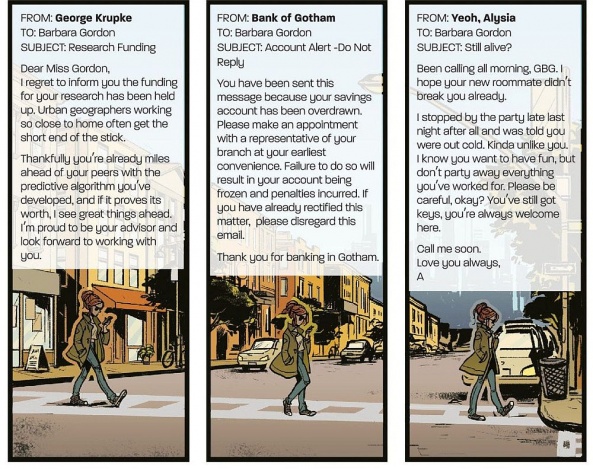
WB: I think the emails effectively tell us about her life right now, or three aspects of it – study, finance, Alysia, but we can’t tell how she’s reacting. If you read three of the emails I’d just received it wouldn’t give you my internal monologue.
SL: That’s true. She also has a lot more friends to talk to here than she did in most of the last run. What does it mean for Barbara to be so integrated into a group of her peers? She seems very social here.
WB: It’s quite a shift.
In terms of Barbara as a character we care about, obviously, it is a positive change. Fans will probably be glad to see it. She’s been having a troubled sort of on-off romance in the last few months of Gail’s run, and here she seems a lot more uncomplicated about randomly hooking up, for instance.
Story-wise, I think you’ve identified it’s probably absolutely necessary to have more supporting characters, as we aren’t in her head, and we only experience her in her interaction with others. If there wasn’t any community, we wouldn’t have nearly so much dialogue, and we wouldn’t get so much sense of her.
Having said that, she still has her secret identity of course — she makes the costume on her own. Her new roommates seem to think she’s maybe a little strange or surprising, bringing houseguests back immediately, and going into her computer-memory mode as she wanders around the place piecing together the events from last night. If you send a new roommate out to get coffee, and she comes back with a friend who’s going to stay over, and tells you coffee was sold out, you are going to wonder.
So, no, I don’t think she’s fully integrated. Which makes sense, as I don’t think any superhero is going to be fully socially adjusted and ‘normal’.
As Frankie says, ‘just think of it like wearing a mask. The real you is still underneath.’ She’s talking about posing for HOOQ pics, but I think Babs is putting on a social mask a lot of the time anyway, and sometimes it slips.
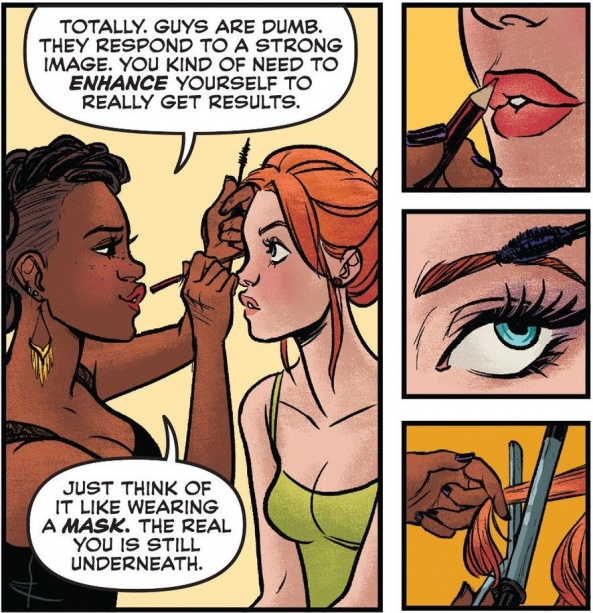
SL: Do you think she is trying to fit in?
WB: I think she’s trying to, and sometimes fails or drops the effort. She’s actually a bit socially awkward or unusual in some ways.
‘What is wrong with you? You won’t speak to me, but you’ll use my storage space to stash your junk without even asking? You’re so selfish,’ says Dinah, one of her best friends. She knows Babs very well, and she’s in the superhero life herself, so that comment is really telling.
Frankie, in the next panel – the very next panel! – is also confused and surprised by her new housemate’s behavior. ‘I didn’t think you’d have guests so soon, but… okay?’
And check out Dinah on the final page. Babs tells her, ‘she’s being really cool about this, you know. You could be nicer.’ Dinah is moody, angry, spiky. She and Babs are people who are used to beating up thugs and big-time villains, with hard-ass quips. They’re not used to sharing a house with a bunch of normal people.
Continued below
SL: Does Barbara really do anything nice for anyone throughout the entire issue?
WB: Well, she recovers someone’s iPad.
SL: That was nice, and she did it with a hangover, too. Bless her heart.
WB: She brings down a criminal.
SL: Yeah, to get her laptop back.
WB: I think she did it because she wanted to. She does it from a sense of social duty and from the satisfaction she normally gets from it. She likes jumping around and fighting. I think you can see she actually likes a punch up. But when she realises she has to get the tablet back, she’s all, ‘REALLY?’
SL: She kicks down the door to the men’s room during that final fight. I thought there was something humorous about that.
WB: I saw it as a subtle pairing to the cover where she’s taking a selfie in the women’s room. Maybe of the same or a similar venue.
You could read more into that. It’s a really strong and assertive moment where she smashes through the ceiling. It’s absolutely a Batman moment, and here’s Babs doing it on her own terms. And yes, kicking a perp into the men’s room could be taken, if you wanted to, as a kind of assertive claiming of space in the ‘men’s room’ of the comics industry — if that represents the comics industry, it’s a pretty depressing image.
I was surprised, and not really pleasantly, that the book pixelates out a guy giving the finger(s) but includes the word ‘bitch’. I think that’s an odd choice of censorship. Though, I suppose it is useful to confirm that Black’s dislike for Batgirl is loaded with sexism, which makes her takedown within explicitly ‘male’, scuzzy space equally relevant.
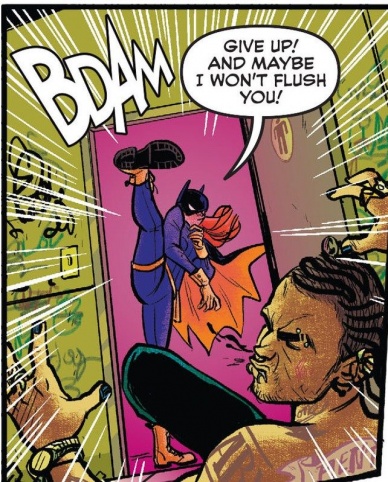
SL: I really found everything about Black Book grating.
WB: In the way he was meant to be grating?
SL: Yes, and he reminds me of Kevin Federline.
WB: One thing that didn’t work for me was his use of hashtags in dialogue. It’s very ‘now’ but I just couldn’t imagine how he was saying it. It works in text but you need to be able to hear a voice in your head.
SL: I really didn’t connect with it either. I didn’t see the intention, do you think it was meant to make him difficult to read?
WB: I thought it was an extension of the ‘damn, bae, you trippin’ – he was meant to represent a certain 2014 mode of discourse, like a human twitter stream. I think we can assume he wasn’t saying ‘hashtag’ every time the symbol comes up, thought, so I don’t think that really succeeds, although it was clever as a visual device.
SL: Do you think there is any significance to him being an information hoarder?
WB: Yes.
It’s a parallel with Batgirl/Oracle’s canonical abilities, updated to a very topical context – ‘The Fappening’/’The Snappening’, revenge porn and so on. This issue must have been written before the nude celebrity leaks of this summer, so it’s just really fortuitous that it taps into that.
Black has a similar ability to Babs, although his is based in tech, and hers is a natural talent. As she says, ‘I know the feeling.’
SL: I think the incorporation of phone messages and online material opens the book up to people who don’t normally read comics.
WB: I agree, the use of social media windows as panels and captions is very interesting and works well. Sometimes text messaging replaces a speech balloon, sometimes a caption, sometimes a whole frame, but it really comes off as a novel storytelling device.
It also conveys the idea that our lives are made up of these various windows and panels. As we look from the world to our phone, we are in a sense living within this framework, like living in a comic book almost in its combination of words and images. We do check out text on our screens, and then look up at people. We do ‘hear’ what our friends say in speech balloons, on Whatsapp. Voices have become textualised.

When Babs is about to enter Genuflex club, we have a Facebook style page, then a view of the club. That is not so different from what we’d actually see if we glanced at our phone, then lowered the phone and looked at the location in front of us. The graffiti in the men’s room and on the cover also factors into this. Texts and social media motifs, like hashtags, also infiltrate our physical world – for instance, on the cover there’s a sticker for HOOQ, which is the DCU version of Tinder, plastered to a mirror.
The QR code image Babs holds up to Black is also a physical object, but it’s read as information. So it offers another interesting comment about digital and analogue and the blurring of the boundaries between them.
The idea that maybe we actually live in a formal world like the one in Batgirl, where we have textual ‘captions’ as we walk to the coffee shop and check our phone, is pretty fascinating, so kudos to the team for that.
SL: There are really interesting comments about the ways we’ve digitized our identities, absolutely. I love how easily information is accessed. Babs doesn’t do detective work in the traditional sense, she has her roommates track down people on Instagram and so on.
WB: It’s very of the moment. It will look very dated in a few years. But on the other hand, consider the Batgirl stories of the late 1960s and 1970s, which were also really trying hard for topicality, and probably falling a little further short. They seem very dated now, with their slang and fashions and gestures towards contemporary politics, but they’re charming and fun, and they’re valuable as social documents. So, the team have decided to make a Batgirl that’s very 2014. Or even very October 2014, considering how fast things move. But that topicality and fashionability is also very, very ‘Batgirl’. It is in keeping with what Batgirl’s been like from the start. So actually that approach really fits.
SL: What elements of the character did the team preserve well in your opinion?
WB: Well, like Batman, Batgirl doesn’t have to be consistent. She has varied over time, so there’s no necessary obligation to ‘preserve’ elements apart from the core features without which she wouldn’t be recognisable. That said, I think the new team has picked up on aspects of what we know of Batgirl and foregrounded them in new ways. Her computer (or social media/digital) skills are the most obvious example, and those are really cleverly updated.
Her eidetic memory is also conveyed in a new and interesting way, with clever layouts and use of digital color that draw on the tropes of video games – such as the way the bottom of the ladder in the chase scene lights up red, as if her mental map was leading her to it as the next move. That also works. It might seem a bit inconsistent that she forgets who she’s been hooking up with, but it’s suggested her memory fails when she’s been drinking, so there’s logic behind it.
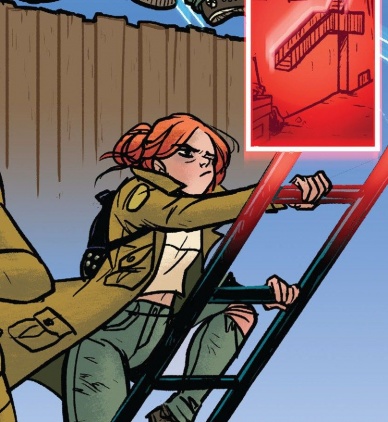
More generally, Babs as having what one of my friends on twitter, Katie Schenkel, called ‘moxie’. Similarly to Bruce, in a way, she just keeps on going even when she’s beaten. That is a strong characteristic. She keeps powering on through.
It’s interesting to see parallels between Batgirl and Batman in this respect, and this is really the last comic you’d expect to find that, as its tone is so different from Snyder and Capullo, but I think we can identify some interesting echoes between Babs and Bruce. Both have a social mask that sometimes fails, and which they sometimes struggle to keep up, and sometimes don’t bother with. You could even note that both sleep until midday.
Babs’ social environment is very different to Bruce’s, but I think we get a hint that she’s also quite rude, potentially antisocial, also impatient, with equally unusual sleeping and eating habits. Which makes sense. You have to have something in common, to dress up as a bat. You have to. And I don’t think that has ever been brought out before. I don’t think this comic is bringing that out forcefully, but the idea is there if you want to see it and work with it.
Continued belowSL: Barbara doesn’t know how to be “normal”. Bruce and her dad taught her how to understand people.
WB: Barbara grew up in a cop family. I don’t think Jim is very socially adept, really. And if we’re still going along with the story about her brother James and her estranged mother, her upbringing was troubled.
SL: She is very literally being taught how to play the part of a normal person here; that’s not her, the glamorous girl Frankie puts together, but she recognizes the value of being seen that way.
WB: I think it’s a little far-fetched that Babs doesn’t seem to know much about make-up, but I guess it’s possible. She has been sharing with Alysia for three years. She hangs around with glamorous girls like Black Canary a lot.
SL: But has she ever tried to be one before?
WB: Well, we don’t know. This Babs has only existed since the New 52 and now she’s had a soft reboot. We can’t refer back to an earlier Babs and say she seems to know about makeup and hair here – and she does, in earlier stories. In the 1970s she was a congresswoman. There’s no way she wasn’t conventionally groomed. I could easily find you panels where she’s wearing lipgloss and mascara. But we can’t really bring that history to bear on this new version.
SL: The other girls seem surprised that she is willing to go along with it.
WB: Dinah is surprised because Dinah knows her. The others aren’t, so much.
SL: That makes me think it’s out of character. It’s also out of character for her to get on Tinder, HOOQ, whatever.

WB: By the way I really like that Dinah is talking with her mouth full on this page. When I wrote My So-Called Secret Identity, people remarked favorably on the fact that the protagonist stands around stuffing her face with food. We often don’t see women eating in popular culture.
The make-over is out of character and Dinah knows that. Babs is doing it for crime fighting reasons. Also, that page usefully tells us she is 21, which is helpful.
SL: How can Barbara possibly be 21?
WB: She became Batgirl when she was 17.
DC Women Kicking Ass, on twitter, suggests that this doesn’t give her any time to be Oracle and that sources confirm privately Oracle never happened. That has never been confirmed in comics to my knowledge, but the linked article proposes this means we could also start moving toward writing The Killing Joke out of continuity. I’ve pointed out in a recent academic chapter that Gail’s run significantly and subtly rewrites The Killing Joke already.
SL: When was Babs paralyzed?
WB: Gail explained concretely in the past how Babs’ narrative fits into that chronology. It’s clearly a tight squeeze. My understanding is that Babs was Batgirl for maybe a year originally, was then paralysed, and has now been Batgirl for about 3 years – far longer than she was originally. It’s comic book continuity. Anyway, whether she was Oracle or not is unconfirmed.
SL: I try not to think about it.
WB: Whether she was paralysed or not, whether she was Oracle, whether The Killing Joke happened and in what way, are important. I think the exact dates and years are always going to be fudged.
SL: What happened is important, when it happened and how the math works out are significantly less important.
WB: I agree, though what happened has also not been confirmed exactly.
SL: I don’t think anyone wants to deal with the fall-out of officially removing Oracle from continuity, so it’s just going to remain unaddressed.
WB: I will say that this Babs doesn’t seem to me exactly like the Babs who has just been through all that trauma in Gail’s run, but then we aren’t given access to her internal monologue, so it’s hard to know exactly how it is affecting her. It isn’t long since Joker forced her to marry him, and since she believed she killed her own brother… and every other distressing episode of Gail’s run.
This doesn’t immediately seem like a Babs dealing with the fallout of that, but what can you do? I don’t think the new team is obliged to process everything that was loaded onto Gail by editorial and cross-overs.
Continued belowThey’re obviously at least recognising the importance of Alysia, and keeping her on the margins. There are enough LGB elements in this issue alone to suggest that they feel she is an important character.
SL: Why do you think she [Alysia] is not in the group?
WB: I think they might have wanted a new start, a new location and new life. Alysia and GBG were misery buddies a lot of the time. Always crying on each other, crashing on the sofa, baking muffins at 3am.
SL: That’s all girls do, stupid.
WB: Oh, well, girls do different things in this issue. Like boys and makeovers.
SL: I know. Sigh. You’re still my favorite person to talk about Batgirl with.
